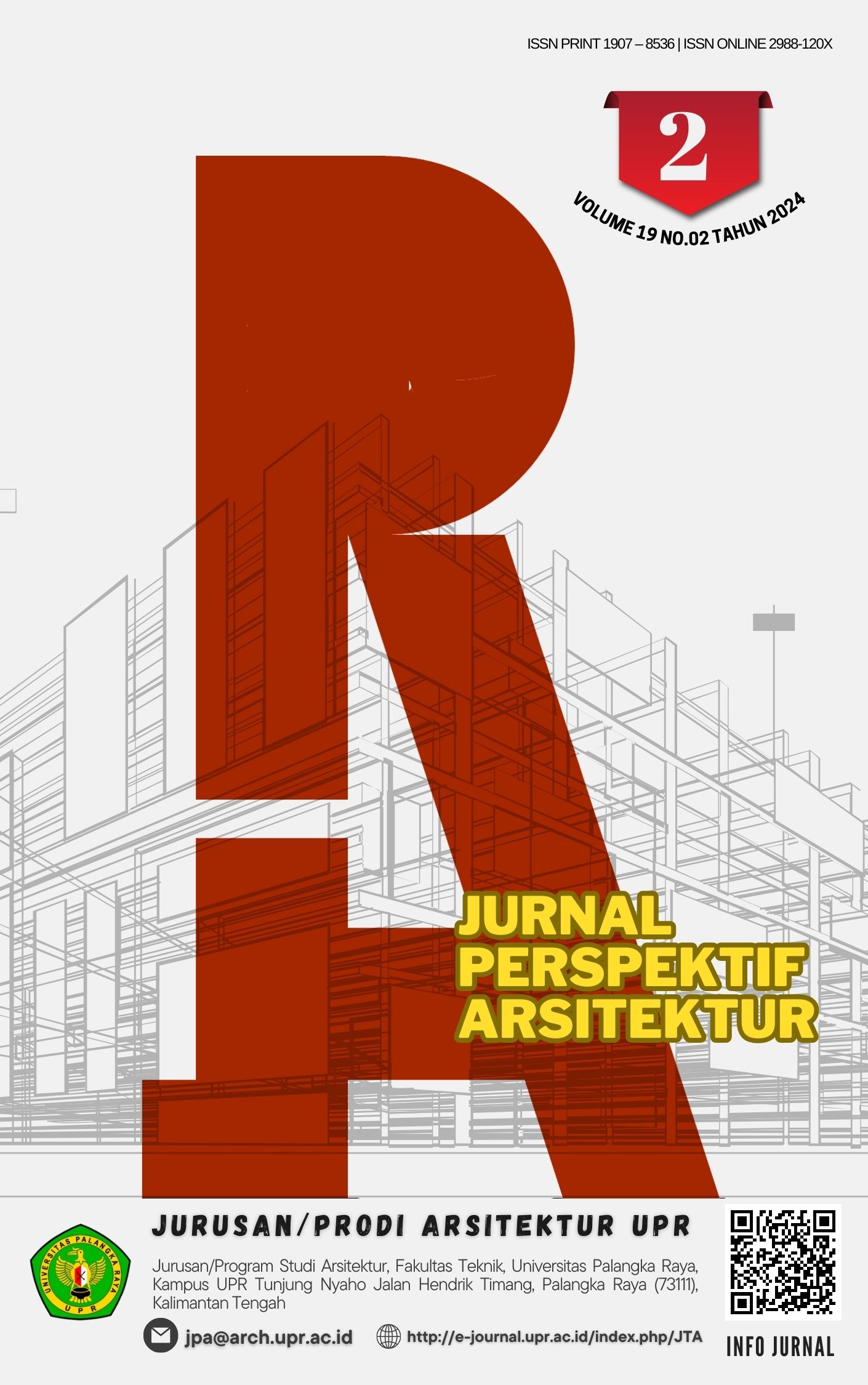KAJIAN PRINSIP PSIKOLOGI ARSITEKTUR PADA PANDUAN SEKOLAH RAMAH ANAK
DOI:
https://doi.org/10.36873/jpa.v19i2.16530Keywords:
kajian psikologi arsitektur , psikologi arsitektur sekolah, sekolah ramah anak, panduan sekolah ramahAbstract
Education plays a vital role in children's lives, both now and in the future. To support this, the United Nations, through UNICEF, has developed guidelines for Child-Friendly Schools (CFS) since 2009. These guidelines aim to create safe and comfortable learning environments that meet all children's educational needs. The design of schools also plays a significant role in shaping the learning environment by creating spaces that cater to children's developmental needs and behaviors. However, the current CFS guidelines do not explicitly mention the use of architectural psychology studies. Instead, they focus more on creating a child-friendly learning environment. Therefore, the purpose of this research is to examine how architectural psychology principles can be applied to the Child-Friendly School Guidelines. This will be achieved through a literature review comparing architectural psychology theories that can be applied to the design of Child-Friendly Schools. The study's results indicate that the existing CFS guidelines have considered the principles of architectural psychology. However, for detailed technical implementation, further references are needed, especially regarding accessibility and safety, architectural form, proportion and scale, and furniture design.
Downloads
References
UNICEF, “Child Friendly Schools Manual,” Unicef, p. 8, 2009, [Online]. Available: https://www.unicef.org/reports/child-friendly-schools-manual
E. Fauziati, “Child Friendly School: Principles and Practices,” First Int. Conf. Child - Friendly Educ., pp. 95–101, 2016, [Online]. Available: https://publikasiilmiah.ums.ac.id/bitstream/handle/11617/7200/1 - Endang Fauziati.pdf?sequence=1#:~:text=A school is considered child,-centered and learning-friendly.
S. Syahroni, S. Sowiyah, and H. Hariri, “the Effectiveness of Child-Friendly Schools on the Character of Learners,” J. Soc. Res., vol. 1, no. 12, pp. 681–688, 2022, doi: 10.55324/josr.v1i12.387.
D. Nafisa, M. S. Barliana, and F. Rahmannullah, “Evaluation of the Facilities and Infrastructure in UPI Kindergarten Lab School Based on the Principles of Child-friendly School Design,” JIPTEK J. Ilm. Pendidik. Tek. dan Kejuru., vol. 15, no. 19, 2022.
E. Nofrida, “Implementasi program sekolah ramah anak di sekolah dasar islam al azhar 60 kota pekalongan,” PROGRAM STUDI MAGISTER PENDIDIKAN GURU MADRASAH IBTIDAIYAH PASCASARJANA UIN K.H. ABDURRAHMAN WAHID PEKALONGAN, Pekalongan, 2023.
D. P. Nabilah and S. Hardiyati, “Penerapan Psikologi Arsitektur Pada Perancangan Sekolah Pendidikan Anak Usia Dini Di Surakarta,” Senthong, vol. 3, no. 1, pp. 166–177, 2020, [Online]. Available: https://jurnal.ft.uns.ac.id/index.php/senthong/index
H. Cao, A. Mária Tamás, and G. Sztranyák, “Application of environmental psychology in kindergarten architectural design,” Pollack Period., vol. 16, no. 3, pp. 169–174, 2021, doi: 10.1556/606.2021.00334.
N. A. Laxmita, S. Suparno, and T. Y. Iswati, “Design Strategy of Vocational School of Fine Arts With Phsycological Architecture Studies,” Arsitektura, vol. 17, no. 1, p. 25, 2019, doi: 10.20961/arst.v17i1.24110.
Nurul Fakriah, “Pendekatan Arsitektur Perilaku Dalam Pengembangan Konsep Model Sekolah Ramah Anak,” Gend. Equal. Int. J. Child Gend. Stud., vol. 5, no. 2, pp. 1–14, 2019, [Online]. Available: www.sekolahramahanak.com
G. Kakkar, “Architectural Psychology: The Impact of Architecture in Human Psyche,” Int. J. Hous. Hum. Settl. Plan., vol. 8, no. 1, pp. 47–52, 2022, doi: 10.37628/ijhhsp.v8i1.915.
L. Madhani and H. Patilima, “Implementasi Aspek Sarana Prasarana Sekolah Ramah Anak di Taman Kanak-kanak,” J. Educ., vol. 10, no. 1, pp. 8–16, 2024, [Online]. Available: https://doi.org/10.31949/educatio.v10i1.6568
Kementerian PPPA, Panduan Sekolah Ramah Anak. 2015.
Yusra Tebe et al., Modul Pilar 1. Fasilitas Belajar Yang Lebih Aman (Satuan Pendidikan Aman Bencana), Versi 2023. SPAB Kemdikbud, 2023. [Online]. Available: https://spab.kemdikbud.go.id/
J. E. R. Kumala, T. E. Darmayanti, and Y. Chandrahera, “Studi Deskriptif Dan Dampak Penerapan Warna Pada Desain Interior Starland Preschool & Kindergarten Di Bandung,” AKSEN J. Des. Creat. Ind., vol. 7 (2), no. April, pp. 1–17, 2023, [Online]. Available: https://journal.uc.ac.id/index.php/AKSEN/article/view/3867/2465
A. Klim-Klimaszewska and S. K. Nazaruk, “Architectural Education in Kindergarten,” in EDULEARN17 Proceedings, 2017, vol. 1, no. March 2017, pp. 8298–8305. doi: 10.21125/edulearn.2017.0535.
I. N. L. Julianto, I. W. A. E. C. Cahyadi, and C. A. Artawan, “Interaktivitas Warna Sebagai Rangsang Visual Pada Ruang Belajar Siswa Sekolah Dasar Kelas 1 – 3 Di Kota Denpasar (Color Interactivity as Visual Stimulation in the Study Room of Grade 1-3 of Elementary Students in Denpasar City,” in Seminar Nasional Sandyakala, 2019, pp. 56–64. [Online]. Available: https://eproceeding.isi-dps.ac.id/index.php/sandyakala/article/download/39/33/
T. H. Sanjaya, “Pendekatan Arsitektur Perilaku Pada Perancangan Madu Playhouse Ubud Bali,” J. PATRA, vol. 5, no. 1, pp. 37–50, 2023, doi: 10.35886/patra.v5i1.502.
V. M. Fatharas, I. Pribadi, and ..., “Penggunaan Material Yang Ramah Anak Untuk Mendukung Keamanan Dan Kenyamanan Anak-Anak Pada Children Center,” … Semin. Intelekt. Muda, pp. 119–128, 2022.
M. Anbari and H. Soltanzadeh, “Child-oriented Architecture from the Perspective of Environmental Psychology,” Eur. Online J. Nat. Soc. Sci. Spec. Issue New Trends Archit. Civ. Eng. Urban Stud., vol. 3, no. 3, pp. 137–144, 2015.
A. Rosalia and R. S. Siswadi, “Kajian Kualitas Ruang Publik Taman Perjuangan Bangsa Palangka Raya,” J. Perspekt. Arsit., vol. 13, no. 2, pp. 406–413, 2018.
A. S. Permana et al., “PERANCANGAN SEKOLAH RAMAH ANAK PADA SDN PONDOK CINA 1 DENGAN Kota Depok ikut berupaya dalam memenuhi hak anak dan melindungi anak di sekolah dengan terlaksananya Kebijakan Kota Layak Anak sejak ditetapkannya Peraturan Daerah Kota Depok Nomor 15 Tahun 2013,” L A K A R J. Arsit., vol. 05, no. 02, pp. 141–153, 2022.

Downloads
Published
How to Cite
Issue
Section
License
Copyright (c) 2024 Carina Sarasati

This work is licensed under a Creative Commons Attribution 4.0 International License.







